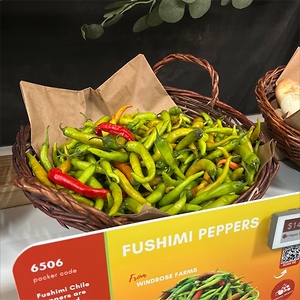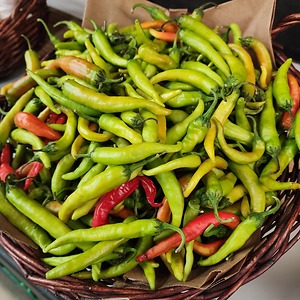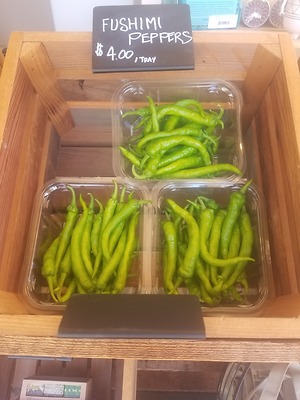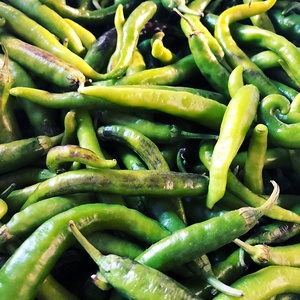


Fushimi Chile Peppers
Estimated Inventory, lb : 0
This item was last sold on : 08/11/24
Description/Taste
Fushimi chile peppers are vegetables with elongated, slender pods. They average 14 to 16 centimeters in length and 1 to 2 centimeters in diameter. They have a conical shape that gradually tapers to a rounded point on their non-stem end. The pods can be straight or slightly curved, and the skin is waxy, semi-smooth, and pale green. When they ripen, these peppers transition to a bright red and develop faint wrinkles. Underneath the skin, their flesh is thin, crisp, and pale green, encasing a central cavity filled with membranes and a few round, flat, cream-colored seeds. Fushimi chile peppers are sweet and fruity, and depending on the variety, carry a medium to hot level of spice.
Seasons/Availability
Fushimi chile peppers are available from summer to fall.
Current Facts
Fushimi chile peppers, botanically classified as Capsicum annum, are an heirloom Japanese pepper that belongs to the Solanaceae, or nightshade, family. Also called Fushimi Togarashi or Fushimi amanaga, these traditional vegetables of Kyoto, Japan, are an early harvest variety considered to be a true frying pepper that’s often used for cooking tempura. Japan is not generally known for having spicy food, which correlates to the fact that Fushimi chile peppers are generally not very hot. Spicier varieties, like the Fushimikara, rank up to 2,500 on the Scoville Scale, which measures pepper heat from 0 to 2,200,000. This Scoville rating indicates that the Fushimikara is about as spicy as an Anaheim pepper. The common Fushimi chile has virtually no heat, which is why they're classified as a sweet pepper.
Nutritional Value
Fushimi chile peppers contain vitamins A, C, B6, and K1. These vitamins are important for vision, wound healing, immune function, energy metabolism, brain development, blood clotting, calcium regulation, and bone, skin, and kidney health. They also protect against free radical cell damage. They are a source of potassium, a nutrient that supports nerve function, regulates muscle contractions, and maintains fluid balance. This mild pepper variety provides the body with copper, an element that helps with iron metabolism and the formation of red blood cells. Fushimi peppers are a significant source of capsaicin, a compound that induces the burning sensation in chiles without causing any injuries to the body. The more capsaicin a person consumes—even from mild peppers like Fushimi—the less sensitive their body becomes to spiciness and other forms of pain like acid reflux-induced heartburn.
Applications
In Japan, Fushimi chile peppers are used similarly to Shishito peppers and are valued for their sweet flavor and crunchy texture. They are eaten fresh, roasted, stir-fried, or sautéed in everyday culinary applications. Fushimi chile peppers are often blistered in oil, seasoned with sea salt, and served as a finger food. Once blistered, the peppers can also be diced and served atop sushi, omelets, rice, stir-fries, and salads. Fushimi chile peppers are popularly battered and fried tempura-style or skewered and grilled over an open fire. They can also be pickled and preserved for extended use. Fushimi chile peppers pair well with garlic, soy sauce, chorizo, grilled fish, shellfish, eggs, tofu, citruses such as lemon, lime, and yuzu, miso, yams, asparagus, eggplant, tomatoes, and lentils. The fresh peppers will last 1 to 2 weeks when loosely stored whole and unwashed in a plastic bag in the refrigerator.
Ethnic/Cultural Info
Fushimi chile peppers, also known as Fushimi Togarashi, are regarded as a traditional vegetable, or "Kyo-yasai", in Kyoto, Japan. Forty-one vegetables have earned the Kyo-yasai label and are highly valued in Kyoto for their exceptional flavor, appearance, and nutritional benefits. They were grown before Japan was introduced to the Westernization of the Meiji era, a time marked by major economic, social, and political changes that led to the modernization of Japan. Kyo-yasai vegetables are believed to have slightly sweeter, purer flavors and are often used in popular vegetarian dishes to showcase the artistic nature of vegetable cooking.
Geography/History
Sweet peppers were first introduced to Japan by Portuguese traders as a seasoning, vegetable, and ornamental plant sometime during the 16th century. By the 20th century, peppers were cultivated extensively in Japan with a fondness for the sweeter varieties such as bell, Shishito, and Fushimi. While the exact origins of Fushimi chile peppers are unknown, the pepper has been grown in the Fushimi region of Kyoto since the Edo period. Today, Fushimi chile peppers are grown predominately in the Gifu prefecture as well as in Kyoto’s Tanba region. They flourish in warm climates with full sun, fertile soil, and mild warm summers. They are gaining global popularity due to their rapid growth and high yields, but outside of Japan and Asia, Fushimi chile peppers can be difficult to find in grocery stores or farmers’ markets. They are often available for purchase as seeds to grown in home gardens.
Recipe Ideas
Recipes that include Fushimi Chile Peppers. One
| Living Shalom |
|
Stir-Fry: Okra, Peppers, & Tempeh |
| Soil Born Farms |
|
Blistered Fushimi Peppers |











